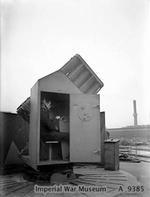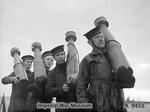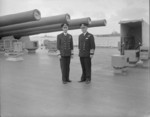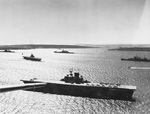King George V
| Country | United Kingdom |
| Ship Class | King George V (1939)-class Battleship |
| Hull Number | 41 |
| Builder | Walker's Naval Yard, Newcastle upon Tyne, England, United Kingdom |
| Laid Down | 1 Jan 1937 |
| Launched | 21 Feb 1939 |
| Commissioned | 11 Dec 1940 |
| Displacement | 38,031 tons standard; 42,237 tons full |
| Length | 745 feet |
| Beam | 103 feet |
| Draft | 32 feet |
| Machinery | 8 Admiralty three-drum small-tube boilers with superheaters, 4 Parsons single-reduction geared turbines, 4 three-bladed propellers |
| Bunkerage | 3,918 tons fuel oil, 192 tons diesel oil |
| Power Output | 125,000 shaft horsepower |
| Speed | 28 knots |
| Range | 5,400nm at 18 knots |
| Crew | 1,631 |
| Armament | 1x2x360mm BL 14in Mk VII guns, 2x4x360mm BL 14in Mk VII guns, 8x2x133mm QF 5.25in Mk I guns, 64x40mm 2pdr pom-pom guns |
| Armor | 374mm main belt, 137mm lower belt, 136mm deck (maximum), 324mm main turrets, 324mm barbettes |
| Aircraft | 4 Supermarine Walrus seaplanes |
| Catapult | One, double-ended |
Contributor: C. Peter Chen
ww2dbaseHMS King George V, launched in 1939, was the lead ship of her class of five battleships; at the time of her commissioning, she was fastest battleship in the British Royal Navy. She was built by Vickers-Armstrong at Walker's Naval Yard at Newcastle upon Tyne, England, United Kingdom. Her main armament of 360-millimeter guns were configured in two different types of turrets; two of the guns were in a 915-ton Mk II turret, while the remaining guns were housed by two Mk III turrets with four guns and weighing 1,582 tons each. Her secondary armament of 16 133-millimeter guns were housed in eight twin turrets, each weighing 81 tons. She initially had 0.5-inch quadruple machine gun mounts for anti-aircraft defense, but starting in 1939 they were gradually replaced by 40-millimeter "pom-pom" guns. After sea trials, she joined the British Home Fleet at Scapa Flow, Scotland, United Kingdom. In early 1941, she embarked Lord Halifax for his journey to the United States, making port call at Annapolis, Maryland, United States.
ww2dbaseOn 24 May 1941 HMS King George V was about 300 to 400 miles away from the site where German battleship Bismarck sank HMS Hood in the Battle of Denmark Strait; after an intense hunt and a subsequent chase, HMS King George V opened fire on Bismarck at 0849 hours, joining other warships already firing on the German battleship. At 0859 hours, she was at the distance of about 16,000 yards from Bismarck and became Bismarck's target, though Bismarck failed to hit her. At 0914 hours, at the distance of 12,000 yards, her secondary armament began to fire. At about 0930 her primary guns briefly ceased firing due to troubles in the safety interlocks for anti-flash protection. Low on fuel, she was sent home as Bismarck had already been seriously damaged; British cruiser Dorsetshire remained behind to ensure Bismarck's sinking.
ww2dbaseStarting in late-1941, HMS King George V operated off Norway to raid German shipping and to provide distant cover for Allied convoys. On 1 May 1942, in foggy weather, she collided with destroyer HMS Punjabi, which was cut in two and was destroyed; King George V suffered a badly damaged bow and was under repair at the Gladstone Dock in Liverpool, England, United Kingdom for nearly two months.
ww2dbaseHMS King George V moved to Gibraltar in May 1943 in preparation for the Allied invasion of Sicily, Italy. During the operation, she bombarded the Sicilian port city of Trapani, bombarded the islands of Levanzo and Favignana, and provided anti-aircraft support. After the Italian surrender, she was among the British warships that escorted Italian battleships Andrea Doria and Caio Duilio and other vessels to Malta. After escorting a convoy to deliver an occupation force to Taranto, Italy, she escorted surrendered Italian ships from Malta to Alexandria, Egypt. During the Allied landings at Salerno, Italy, she provided gunfire support.
ww2dbaseIn late 1943, HMS King George V received 20 20-millimeter Oerlikon cannon.
ww2dbaseBetween Feb and Jul 1944, HMS King George V remained in Liverpool for an overhaul, receiving additional radar gear, anti-aircraft weapons, among other things. Her full displacement increased to 44,460 tons after this overhaul.
ww2dbaseIn late 1944, HMS King George V set sail for Alexandria, Egypt, and was diverted briefly to bombard German positions in the Mediterranean Sea. She arrived in Ceylon on 15 Dec 1944. On 16 Jan 1945, she set sail with other warships, bombarding Japanese oil refineries on Sumatra, Dutch East Indies. In late Mar 1945, she bombarded airfields on the Sakishimo Islands of Ryukyu Islands, Japan. On 4 May, she bombarded airfields in the Ryukyu Islands. In mid-Jul, she joined American battleships in the bombardment of Honshu, Japan. She supported carriers during the Okinawa Campaign. During the night of 29 to 30 Jul 1945, she bombarded Hamamatsu, Honshu, Japan, which would prove to be her final combat action in the Pacific War. She was present at the Japanese surrender ceremony in Tokyo Bay, Japan.
ww2dbaseIn Jan 1946, HMS King George V provided transport for the Duke and Duchess of Gloucester on their official visit to Australia, returning to Portsmouth, England in Mar 1946. She was the flagship of the British Royal Navy Home Fleet until Dec 1946 when she became a training ship. In Jun 1950, she was placed in reserve, and in Dec 1955 her status was demoted to extended reserve. In 1958, she was moved from her berth in Gare Loch, Scotland as she was sold to the firm Arnott Young and Company of Dalmuir, Scotland for scrapping.
ww2dbaseSource: Wikipedia
Last Major Revision: Dec 2014
Battleship King George V (41) Interactive Map
Photographs
 |  |  |  |
King George V Operational Timeline
| 1 Jan 1937 | Battleship King George V was laid down. |
| 21 Feb 1939 | Battleship King George V was launched. |
| 16 Oct 1940 | Battleship King George V departed Newcastle upon Tyne, England for Rosyth, Scotland, both of which were in the Unite Kingdom. |
| 11 Dec 1940 | HMS King George V was commissioned into service. |
| 6 Feb 1941 | HMS King George V arrived at Scapa Flow, Scotland, United Kingdom after delivering Lord Halifax to the United States. |
| 13 Apr 1941 | British battleship HMS King George V, light cruiser HMS Nigeria, and destroyers HMS Mashona, HMS Electra, and HMS Escapade departed Scapa Flow, Scotland, United Kingdom at 0107 hours in poor weather. |
| 22 May 1941 | HMS King George V patrolled the waters off Iceland. |
| 1 May 1942 | HMS King George V, in thick Atlantic fog, accidentally rammed and sank HMS Punjabi 165 miles northeast of Iceland at 1545 hours. HMS Punjabi was broken in half, with the stern sinking, depth charges exploding meanwhile, killing 49. The forward piece remained afloat for some time, allowing 169 people to be taken off. An additional 40 survivors were picked from the sea. HMS King George V suffered a 40-foot gash in the bow, forcing her to leave her convoy escort station to sail for Britain for repairs. |
| 4 May 1942 | HMS King George V arrived at Scapa Flow, Scotland, United Kingdom. |
| 9 May 1942 | HMS King George V arrived at the Gladstone Dock in Liverpool, England, United Kingdom to repair the damage caused by the 1 May 1942 collision with HMS Punjabi. |
| 1 Jul 1942 | HMS King George V arrived at Scapa Flow, Scotland, United Kingdom. |
| 10 Jul 1942 | HMS Cumberland covered passage of HM Battleship King George V from Liverpool to Scapa Flow. |
| 12 Jul 1943 | HMS King George V bombarded Trapani, Sicily, Italy. |
| 28 Oct 1944 | HMS King George V departed Scapa Flow, Scotland, United Kingdom. |
| 1 Dec 1944 | HMS King George V departed Alexandria, Egypt. |
| 15 Dec 1944 | HMS King George V arrived at Trincomalee, Ceylon. |
| 16 Jan 1945 | HMS King George V departed Trincomalee, Ceylon. |
| 30 Mar 1945 | British warships including the battleship HMS King George V, under the command of Vice Admiral Sir Bernard Rawlings, and a carrier force led by HMS Illustrious, commanded by Rear Admiral Sir Philip Vian, participated in an attack on the Sakashima Islands, 180 miles south-west of Okinawa, Japan. |
| 4 May 1945 | HMS King George V bombarded airfields in the Ryukyu Islands, Japan. |
| 18 Jul 1945 | American battleships USS North Carolina, USS Alabama, USS Iowa, USS Missouri, and USS Wisconsin and British battleship HMS King George V bombarded Hitachi, Ibaraki Prefecture, Japan with 2,000 shells; the Taga Works and Mito Works of Hitachi Manufacturing Company were moderately damaged, and the Yamate Plant and the copper refining plants of Hitachi Mine were lightly damaged; civilian housing areas were also attacked, causing many deaths. Japanese battleship Nagato was damaged in port at Yokosuka, Japan by aircraft from carrier USS Shangri-La; a Japanese destroyer, a submarine, and three smaller vessels were sunk during the attack on Yokosuka. Aircraft from USS Yorktown struck the Tokyo area. P-47 Thunderbolt and P-51 Mustang aircraft of US Far East Air Forces attacked various targets on Kyushu and the Ryukyu Islands, Japan, focusing largely on communications lines, bridges, shipping, and population centers. |
| 30 Jul 1945 | American battleships USS South Dakota, USS Indiana, and USS Massachusetts, joined by British battleship HMS King George V (this would be her final combat action of the war) ended a two-day bombardment of Hamamatsu, Shizuoka Prefecture, Japan. Meanwhile, carrier fighters from USS Ticonderoga (Air Group 87), USS Shangri-La, and USS Yorktown attacked airfields, railroads, and tactical targets east and west of Hamamatsu, generally the larger Kyoto-Kobe-Osaka region and the Tokyo region. Destroyer Yukikaze suffered minor damage and one killed by carrier aircraft in Miyatsu Bay on the coast of the Sea of Japan. |
Did you enjoy this article or find this article helpful? If so, please consider supporting us on Patreon. Even $1 per month will go a long way! Thank you. Share this article with your friends: Stay updated with WW2DB: |
Visitor Submitted Comments
3 Jan 2016 06:32:46 AM
In the history above it say that it was escort ship on an official visit to Australia in Jan 45 and returned to UK in Mar 45, but this should be corrected to 1946!!!
12 Oct 2018 12:52:51 AM
At a cost of £7.5 million the battleship King George V was as expensive to build as a new ordnance or aero-engine factory and, actually, took longer to build. With a crew of around 1,500 men, less than a large wartime factory, this emblem of Great Britain’s naval power was effectively a small town in miniature (for example the ship’s catering operations was comparable to that of a large hotel). KGV could carry over 3,000 tons of fuel, the same as a small tanker and her steam turbines could generate 125,000 horsepower (93MW) roughly the output of a contemporary power station. Her two largest quadruple gun turrets with all their equipment weighed over 1,500 tons (nearly one thousand times more than a complete Army 25-Pounder battery) and each of the 14in (356mm) guns, which could fire a shell weighing more than half a ton to a distance of 35 Kilometres, weighed around 8 tons. Additionally the mighty KGV carried the same quantity of armour plate as used by many thousands of tanks.
6 Jun 2019 11:07:07 AM
Hello my name is Marie Hassall and my grandfather is Leonard Hassall who served on King George v as a stoner. I would like to hear from anyone who served on this ship
12 Apr 2020 12:21:53 AM
Can someone please clarify if marines were on this ship and how I can get a list of them please? Thank you.
25 Feb 2021 12:43:48 AM
Marines did serve on this ship not sure how you would get a list though there is a Facebook page so maybe that could help! My father served on the KGV he spoke of pulling into Australia for repairs and having freedom of the city for 48 hours
1 Apr 2021 05:58:51 AM
Interesting, my Grandad was a Royal Marine on the KGV and he also spoke about having time in Australia.
8 Jan 2022 06:48:43 PM
My grandfather served on the King George V during WW2. There's a website with photos he took if you're interested (search robert hunter devlin ww2)
19 Jan 2022 02:54:37 PM
My father a Royal Marine served on KGV for a long period.
13 Sep 2022 02:44:59 PM
im looking fot my grandads navy info his name is alexander japp he was on king george the fifth in ww2
30 Oct 2022 12:22:18 PM
My Uncle Bernard Young. Was Lt Commander Young I believe in command of the main Guns at the end of the war. I have Many Photos of KGV , and his personal log,his first entry Joined KGV at Scapa Flow 1939 and His last Entered Tokyo Bay
All visitor submitted comments are opinions of those making the submissions and do not reflect views of WW2DB.
» Battle of Denmark Strait
» Invasion of Sicily and Italy's Surrender
» Operation Avalanche
» Okinawa Campaign
» Preparations for Invasion of Japan
» Japan's Surrender
- » 1,150 biographies
- » 337 events
- » 44,024 timeline entries
- » 1,242 ships
- » 350 aircraft models
- » 207 vehicle models
- » 375 weapon models
- » 123 historical documents
- » 260 facilities
- » 470 book reviews
- » 28,597 photos
- » 432 maps
Winston Churchill, on the RAF
Please consider supporting us on Patreon. Even $1 a month will go a long way. Thank you!
Or, please support us by purchasing some WW2DB merchandise at TeeSpring, Thank you!
14 Aug 2015 05:59:08 AM
thanks